TJX Cos Bundle
How Did TJX Companies Revolutionize Retail?
Discover the fascinating journey of The TJX Companies, a retail giant that transformed the discount shopping experience. From its humble beginnings, TJX has consistently challenged traditional retail models. Learn how its innovative approach to off-price merchandise and the "treasure hunt" shopping experience have driven its remarkable success. The TJX Cos SWOT Analysis offers deeper insights.
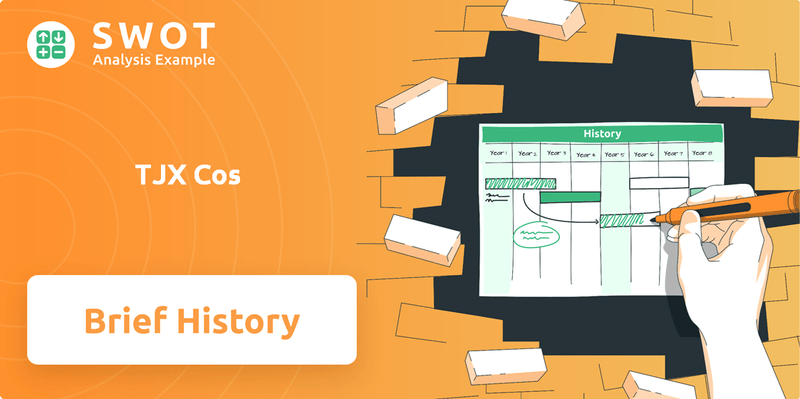
This brief history of TJX Cos explores the evolution of TJ Maxx history, from its founding as a subsidiary to its current status as a global leader. The company's strategic focus on the off-price retail industry, including the Marmaxx Group, has enabled it to navigate market fluctuations and maintain strong financial performance. Understanding TJX Cos history is crucial for anyone interested in the dynamics of discount retailers and the broader retail industry.
What is the TJX Cos Founding Story?
The story of The TJX Companies, Inc., or TJX Cos, began in 1976. It all started when Bernard Cammarata was brought in by Zayre Corp., a discount department store chain. He was given the task of creating a new retail concept focused on off-price sales of family apparel and home fashions.
This initiative was designed to offer brand-name merchandise at lower prices, targeting consumers looking for value. The idea was to buy merchandise from various sources, like manufacturers and retailers, at discounted rates. This merchandise would then be sold at prices significantly below those of regular retailers. The first two T.J. Maxx stores, which followed this model, opened in Massachusetts in 1977.
The initial funding for T.J. Maxx came from its parent company, Zayre Corp. Later, in the late 1980s, Zayre Corp. restructured. Despite losses at Zayre stores, T.J. Maxx remained profitable. This led to Zayre Corp. focusing on TJX, selling off its Zayre chain. In 1989, the company reorganized as The TJX Companies, Inc., with Bernard Cammarata as CEO and President. This shift highlighted the success of the off-price model.
The early years of T.J. Maxx were marked by a focus on opportunistic buying and expansion.
- The first two T.J. Maxx stores opened in 1977 in Massachusetts.
- The business model involved acquiring merchandise at discounted prices and selling it at a lower cost.
- The company's growth was supported by its parent company, Zayre Corp.
- The restructuring of Zayre Corp. in the late 1980s led to a strategic shift towards TJX.
TJX Cos SWOT Analysis
- Complete SWOT Breakdown
- Fully Customizable
- Editable in Excel & Word
- Professional Formatting
- Investor-Ready Format
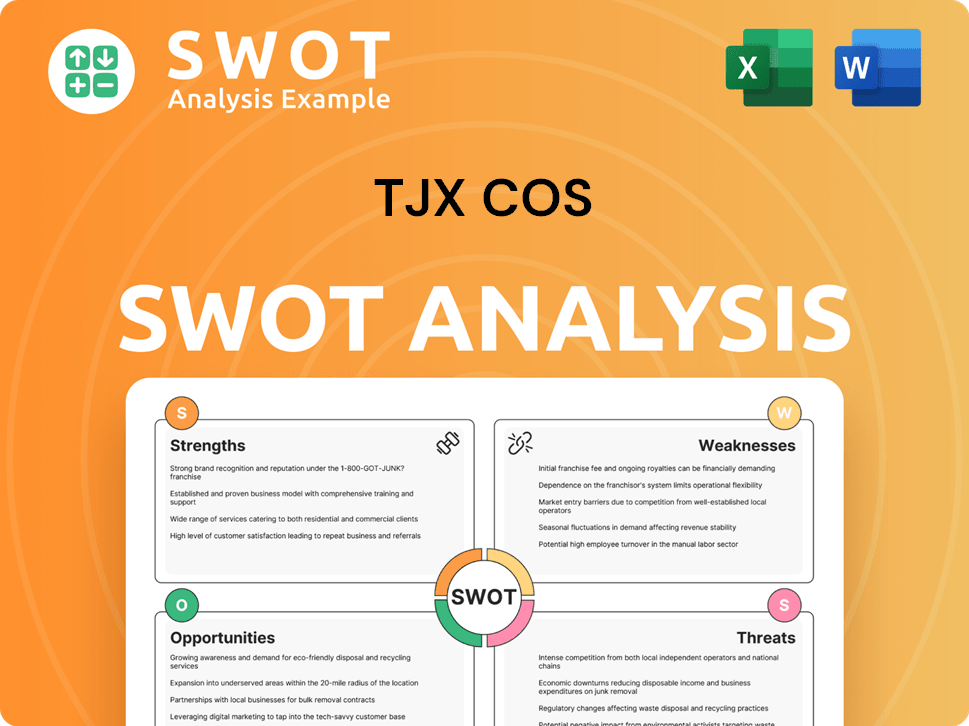
What Drove the Early Growth of TJX Cos?
Following its establishment, the company, now known as The TJX Companies, Inc., experienced significant growth. This expansion was marked by strategic acquisitions and the introduction of new brands. These moves diversified its retail portfolio and broadened its geographical footprint within the retail industry.
In 1989, after Zayre Corp. merged with its profitable subsidiary, TJX became the legal successor, trading on the New York Stock Exchange. A key early move was the 1990 acquisition of Winners Apparel of Canada. This marked the company's first international expansion, setting the stage for Winners to become a leading off-price retailer in Canada.
In 1992, the company launched HomeGoods in the U.S., expanding into home fashions. The introduction of T.K. Maxx in the U.K. and Ireland in 1994 brought the off-price concept to Europe. T.K. Maxx grew to become Europe's only brick-and-mortar off-price retailer of significant size.
A pivotal acquisition occurred in 1995 with the purchase of Marshalls, the second-largest off-price retailer in the U.S. This doubled the company's size, with the combined store count of T.J. Maxx and Marshalls exceeding 1,000. The T.J. Maxx and Marshalls brands were later consolidated under The Marmaxx Group.
The company launched A.J. Wright in 1998, targeting moderate-income consumers, which expanded nationally by 2004. HomeSense was introduced in Canada in 2001. The company's revenue surpassed $10 billion in 2001 and nearly $12 billion in 2002. By 2004, revenue was almost $15 billion, and the company ranked 141st on the Fortune 500 list. For more details on the company's financial structure, consider reading Revenue Streams & Business Model of TJX Cos.
TJX Cos PESTLE Analysis
- Covers All 6 PESTLE Categories
- No Research Needed – Save Hours of Work
- Built by Experts, Trusted by Consultants
- Instant Download, Ready to Use
- 100% Editable, Fully Customizable
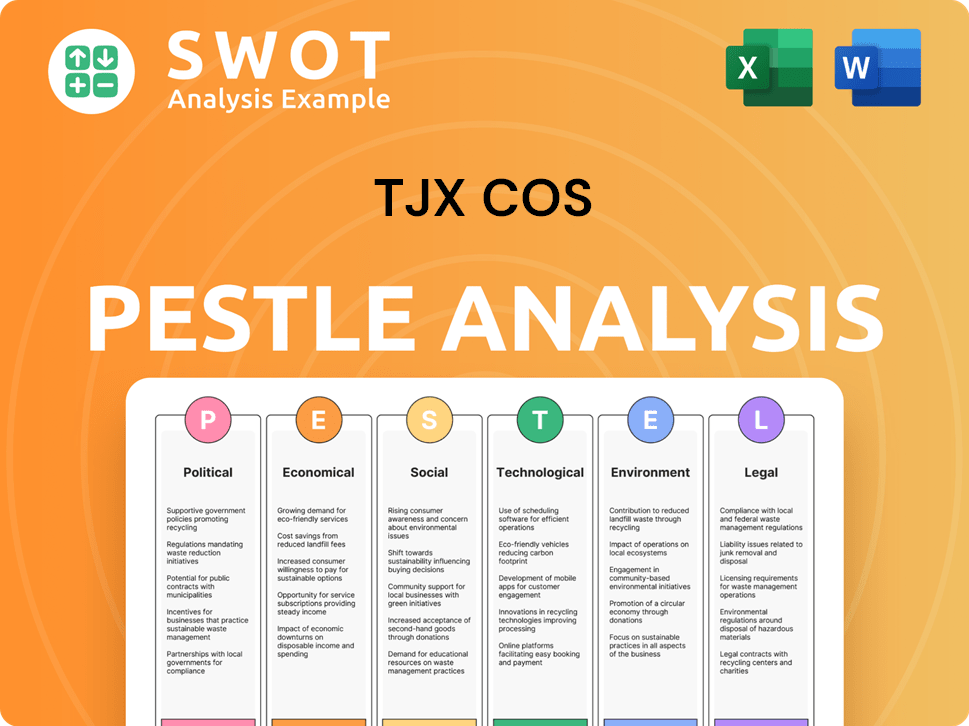
What are the key Milestones in TJX Cos history?
The TJX Cos history is marked by significant growth and strategic expansions within the retail industry. From its early beginnings to its current global presence, the company has consistently adapted to market changes, achieving key milestones that have solidified its position among discount retailers.
| Year | Milestone |
|---|---|
| 1994 | Established T.K. Maxx in the U.K. and Ireland, marking the beginning of international expansion. |
| 2015 | Acquired Trade Secret in Australia, further expanding its global footprint. |
| 2025 | Entered into a joint venture with Grupo Axo in Mexico and acquired stakes in Multibrand Outlet Stores (Mexico) and Brands for Less (UAE and Saudi Arabia), continuing international growth. |
| 2026 (planned) | Planned entry into Spain with the TK Maxx banner. |
One of the most significant innovations of the TJX Companies is its 'treasure hunt' business model, which offers a constantly changing assortment of brand-name and designer merchandise at prices significantly below full-price retailers. This model is supported by opportunistic buying from a global network of over 21,000 vendors, enabling the company to procure merchandise at substantial discounts.
The core innovation is the off-price retail model, offering brand-name and designer merchandise at discounted prices. This model drives rapid inventory turnover and maintains low operating costs, providing value to customers.
A global network of over 21,000 vendors across approximately 18 countries allows for opportunistic buying. This network enables the company to acquire merchandise at significant discounts due to overstocks, closeouts, and production cancellations.
The 'treasure hunt' model ensures rapid inventory turnover. This constant flow of new merchandise keeps customers engaged and coming back to discover new finds.
Despite its successes, TJX has faced challenges, including a significant data breach in 2003 that compromised customer data. The company has also navigated economic downturns and the COVID-19 pandemic, demonstrating resilience through its flexible business model.
In 2003, a significant data breach compromised customer data, leading to substantial investments in IT security. This event highlighted the importance of robust data protection measures.
The company demonstrated resilience during the 2008 recession, showcasing the strength of its off-price model. This model allows it to thrive even in challenging economic times.
The COVID-19 pandemic presented significant challenges, including temporary store closures. The company adapted by focusing on online sales and adjusting its inventory management.
In Q1 FY26, TJX noted some margin compression, with pretax profit margin decreasing by 80 basis points to 10.3%. This indicates pressures on profitability despite strong sales growth.
Increased inventory levels were observed in Q1 FY26, potentially impacting future profitability. Managing inventory effectively is crucial for maintaining financial health.
TJX Cos Business Model Canvas
- Complete 9-Block Business Model Canvas
- Effortlessly Communicate Your Business Strategy
- Investor-Ready BMC Format
- 100% Editable and Customizable
- Clear and Structured Layout
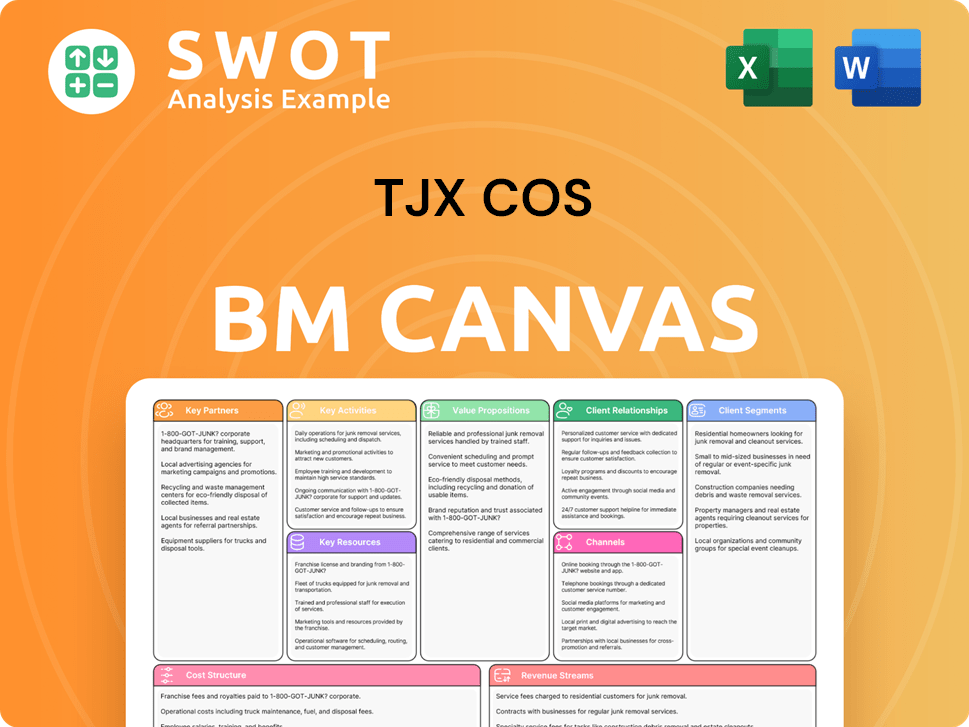
What is the Timeline of Key Events for TJX Cos?
The TJX Cos history is a story of strategic growth and adaptation within the retail industry. From its origins in 1919 as a ladies' hosiery business to its current status as a global discount retailer, the company, formerly known as The TJX Companies, Inc., has consistently expanded its footprint and diversified its offerings, solidifying its position in the market. The evolution of the company reflects a keen understanding of consumer preferences and a commitment to providing value, which has driven its success over the years.
| Year | Key Event |
|---|---|
| 1919 | Max and Morris Feldberg establish a ladies' hosiery business in Boston, Massachusetts, which later becomes Zayre Corporation. |
| 1976 | Bernard Cammarata is recruited by Zayre Corp. to develop a new off-price retail chain. |
| 1977 | The first two T.J. Maxx stores open in Auburn and Worcester, Massachusetts. |
| 1987 | Zayre forms The TJX Companies, Inc. as a subsidiary. |
| 1989 | Zayre Corp. reorganizes and merges with its subsidiary, becoming The TJX Companies, Inc., and begins trading on the NYSE. |
| 1990 | TJX acquires Winners Apparel in Canada, marking its first international expansion. |
| 1992 | HomeGoods is launched in the U.S., diversifying into home fashions. |
| 1994 | T.K. Maxx is launched in the U.K. and Ireland, introducing the off-price concept to Europe. |
| 1995 | TJX acquires Marshalls, significantly expanding its U.S. retail footprint. |
| 1996 | TJX Companies Inc. is added to the S&P 500 Composite Index. |
| 1998 | A.J. Wright is launched in the eastern U.S., targeting moderate-income consumers. |
| 2001 | HomeSense is introduced in Canada. |
| 2003 | TJX experiences a major data breach, leading to increased investment in IT security. |
| 2015 | TJX acquires Trade Secret in Australia. |
| Fiscal Year 2025 (ended Feb 1, 2025) | Net sales reach $56.4 billion; diluted EPS is $4.26; the company operates 5,085 stores globally; TJX enters a joint venture with Grupo Axo in Mexico and Brands for Less in the UAE and Saudi Arabia. |
| Q1 Fiscal Year 2026 (ended May 3, 2025) | Net sales are $13.1 billion; diluted EPS is $0.92. |
| Early 2026 | TJX plans to enter Spain with its TK Maxx banner. |
TJX continues its global expansion, with plans to enter new markets and grow its existing presence. The company's strategy involves adapting its off-price model to different regions, as seen with the upcoming launch of TK Maxx in Spain. This expansion is a key part of its long-term growth strategy.
The company anticipates continued financial growth. For fiscal year 2026, TJX plans to repurchase approximately $2.0 to $2.5 billion of stock and expects to pay an annual dividend of $1.70 per share. Analysts predict earnings to grow by 9.57% next year, from $4.18 to $4.58 per share.
TJX is investing in its operations to support future growth. Capital expenditures are projected to be between $2.1 billion and $2.2 billion, primarily for store renovations, new store openings, and enhancements to office and distribution centers. These investments are crucial for maintaining its competitive edge.
TJX focuses on driving sales through its compelling merchandise and 'treasure-hunt' shopping experience. The company's business model, centered around offering a wide variety of brands at discounted prices, continues to attract customers. This approach is designed to ensure its continued leadership in the discount retailers sector.
TJX Cos Porter's Five Forces Analysis
- Covers All 5 Competitive Forces in Detail
- Structured for Consultants, Students, and Founders
- 100% Editable in Microsoft Word & Excel
- Instant Digital Download – Use Immediately
- Compatible with Mac & PC – Fully Unlocked
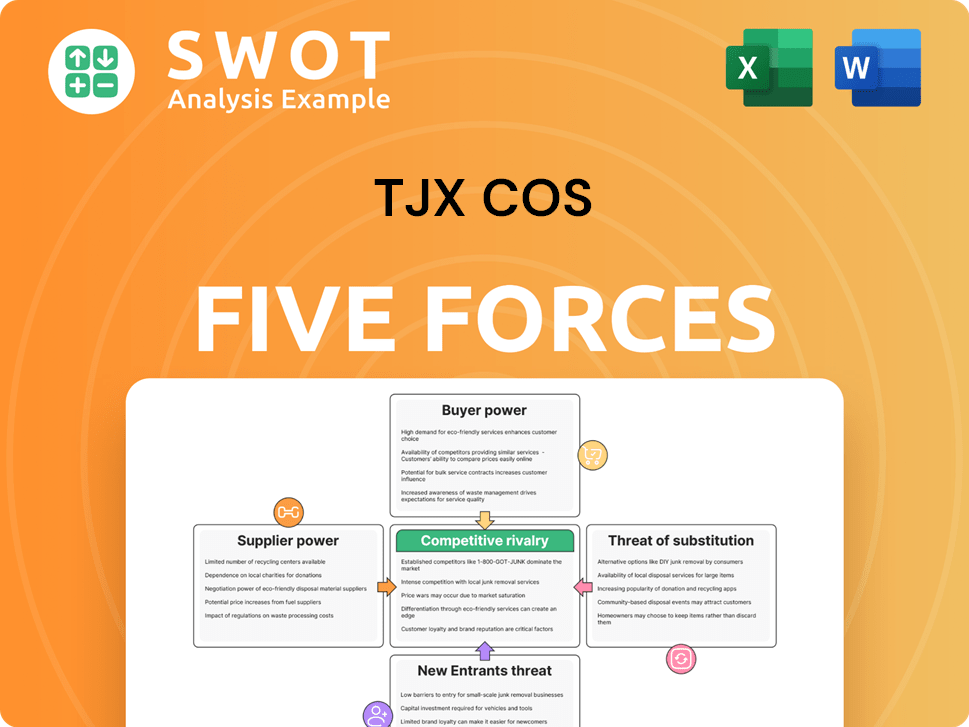
Related Blogs
- What is Competitive Landscape of TJX Cos Company?
- What is Growth Strategy and Future Prospects of TJX Cos Company?
- How Does TJX Cos Company Work?
- What is Sales and Marketing Strategy of TJX Cos Company?
- What is Brief History of TJX Cos Company?
- Who Owns TJX Cos Company?
- What is Customer Demographics and Target Market of TJX Cos Company?
Disclaimer
All information, articles, and product details provided on this website are for general informational and educational purposes only. We do not claim any ownership over, nor do we intend to infringe upon, any trademarks, copyrights, logos, brand names, or other intellectual property mentioned or depicted on this site. Such intellectual property remains the property of its respective owners, and any references here are made solely for identification or informational purposes, without implying any affiliation, endorsement, or partnership.
We make no representations or warranties, express or implied, regarding the accuracy, completeness, or suitability of any content or products presented. Nothing on this website should be construed as legal, tax, investment, financial, medical, or other professional advice. In addition, no part of this site—including articles or product references—constitutes a solicitation, recommendation, endorsement, advertisement, or offer to buy or sell any securities, franchises, or other financial instruments, particularly in jurisdictions where such activity would be unlawful.
All content is of a general nature and may not address the specific circumstances of any individual or entity. It is not a substitute for professional advice or services. Any actions you take based on the information provided here are strictly at your own risk. You accept full responsibility for any decisions or outcomes arising from your use of this website and agree to release us from any liability in connection with your use of, or reliance upon, the content or products found herein.